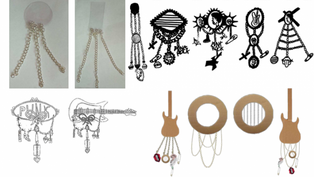Design with humanity – a living curriculum
- Megan St Clair Morgan
- Jun 18, 2020
- 5 min read
Updated: Sep 19, 2020

Travelling between London College of Fashion (LCF) and Zaatari Refugee camp on the Syrian/ Jordan border these past 5 years has been a time of immense learning for me; Zaatari itself and everyone who lives there are teachers of the most extraordinary kind, showing us what resilience, innovation and sustainability truly are – everything happens through being in vital and reciprocal relationship.
Before the arrival of COVID-19, the people of Zaatari had already shown me what it means to be in lock down and away from home, for what is now their 9th year and how it is often kindness, generosity and having each - others backs, that helps navigate the hardest of times.
I have often felt lost when working there, in between worlds of a very different kind, but I know now that the other side of feeling lost, is where more than you know exists – it’s where new ways of working manifest, it’s where new knowledge lives. Whilst the experience of feeling taught by Zaatari feels continuous, it’s not only what happens there, it’s how you return here, what is part of a placeless living conversation with the self, over what seems to have changed forever.
I have wanted for a long time now, to bring all I have learned back so far to LCF and intuitively have felt that opportunities to create experiential curricular, which can touch as much on life skills, as the gaining of knowledge has felt right.
Working closely with course leaders has given us all a way to create a ‘Living curriculum,’ a rapidly responsive curriculum, which sitting alongside the formal one, can also offer time and space for processing and responding to dramatic and fundamental change happening on a daily basis, through ones work and in real time. And crucially, at a moment when there is a window for realising an alternative future for our sector, in keeping with what our planet and people need.

The first of these projects has taken place in the form of a provocation to the BA (Hons) Fashion Jewellery 2nd year students
To begin with, the project, entitled “Precious Future” asked students to work within the same materials and tools restraints as Zaatari, ie, to design only with what is around you now. For some, this was from a hotel room in China, as quarantine was lived through, for others from their parent’s home, where the kitchen became the studio, the lab the place for experimentation and imagining.
Half way through the project, we asked the students to stop – to give up their project – and to allow it to pass to a fellow student, who would take it on, as if their own and develop it, whilst honouring the input of the student who first started the work.
Towards the end of the project, the students received back, their now altered work, with the hand of the other upon it and without undoing the work of their unexpected collaborator, took the project over the finish line.
“This way of experiential teaching touches on the core of what it is we are trying to achieve, which is to encourage students to develop unique strength of vision that is adaptable and resilient in changing environments and situations. It has been encouraging and inspiring to see the generosity in the students’ responses on the work of the other.” – Bernadette Deddens, Course Leader BA (Hons) Fashion Jewellery
What we were exploring and experiencing, whilst being utterly incomparable to what the citizens of Zaatari have had taken away from them, was the visceral experience of having one’s own creative process halted, severed and suddenly taken out of your hands – what resourcefulness, adaptability, or resistances might surface?

How are we, in times of colossal and sudden change?
It was fascinating and humbling to see the different student responses to the request to give up their work; from enthusiasm to do so straight away, to developing methods where the work could be shared openly between them, but where mutual influencing of the project was happening, to finding it very hard to let go and allow the swap to happen at all.
The role of the tutor was also key, as our own creativity connected to what was possible between these radical collaborations; in some senses a project which opened up a cross generational experience of what now asks of us too.
Collating insight from students on the course – we'll be exploring how this project was lived, by the remarkable students who took part. It's courageous and inspiring to see students take this on, in a time of such fundamental change for us all.
Mingjie Yang and Tianqi Kiki Li
Mingjie’s project was exploring praying, and expressing care and compassion for each other through meditation and mindfulness. Kiki helped her to define universal materials and objects, that made a meaningful impact on the final designs.
Through conversations between the pair, Mingjie went on to explore the topic of 'prayer' and the design direction this could take, to involve prayer associated objects and materials like candles with the design. Following discussions with tutor Husam, this developed into including further in-depth meaning and information within the button itself. A great example of how discussion and insight from tutors can shape the design process.
Kiki's project aimed to explore "sustainability from the perspective that the world is a community, sharing is caring. In communities like Za’atari, sharing resources like water, news, food and so on is a way to help each other." Working with Mingjie, they looked toward focusing on specific resources – Kiki decided upon food and water. Kiki's final pieces form refillable water transfusion bags, that can be worn as pins, and a pearl necklace made from bread.
Polina Voynova and Faith-Melody Ramautar
Polina's work looked toward the feelings of "what it is like when all you have left from your home have only pieces of memories." Looking toward the continued resilience of those from Za'atari, Poline started her work in exploring the concept of 'balance'. Working with Faith, it inspired Polina to focus on the idea of 'what home is'. Deciding to present her work on photos of refugee women and their children.
"I imagined my jewellery to be a nice pretty thing not only for our society but also kind of wearable symbol for people who have faced this problem themselves. ...dedicated to all lost homes and people in search of balance..." – Polina
Faith developed a set of jewellery that revolved around music and subculture as a form of empowered protest. She focussed her protest on the position of women of colour in a society of injustice and prejudice. Drawing on 1970ies punk the designs subvert and question traditional formats, such as a cameo showing a woman with an afro and a chatelaine featuring an afro comb.
Ollie Banks and Lang Jin
Ollie’s project focussed on creating jewellery pieces, that are games that require cooperation. The very nature of the swap was a cooperation that was woven into the narrative. Developing the idea of an interactive piece of jewellery that could be worn, and played with by the children in Zaatari.
"The pieces of jewellery look towards creating a community and narrative between people. The naughts and crosses bracelets are both needed, for example, in order to play - a person could not use the board without having somebody that had the opposite bracelet. The ring though, can be worn by one person and can be an individual piece of jewellery. The theme and idea throughout the design process of the ring was to create a need for sharing and swapping and interaction with somebody else." – Ollie Banks
Lang’s project was a play on the idea of healing and our modern desire to “pop” a pill to make things instantly better. Ultimately this became a metaphor on placebo’s and a commentary on escapism, when dealing with problems from how we treat the planet and its resources.
"Ollie’s work made me consider the positioning on the body and the use of ice to evoke the idea of climate change – I didn’t use real ice in my final designs, but my material choices and textures were inspired by Ollie’s ice ring and air bangle." – Lang Jin






























Comments